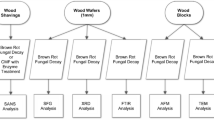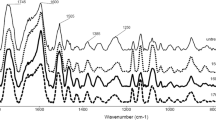Abstract
The effect of hot-water extraction and two types of fungal decay, brown rot and white rot, on wood crystalline cellulose structure was examined using a combination of X-ray diffraction (XRD) and 13C solid-state nuclear magnetic resonance (NMR) spectroscopy. Although having opposite effects on the overall crystallinity of the wood, the XRD results revealed that both extraction and brown-rot decay caused a significant decrease in the 200 crystal plane spacing (d-spacing) not seen for the white-rotted samples. This effect was found to be additive, as samples that were first extracted, then decayed showed a double decrease in d-spacing compared to that caused by extraction alone. This suggested that, despite having a similarly directed effect on the spacing of the crystalline planes, the two treatment methods facilitate a decrease in d-spacing in different ways. NMR results support the conclusion of differing structural effects, suggesting that the hot-water extraction procedure was causing a co-crystallization of existing crystalline domains, while the brown rot decay was depolymerizing the cellulose chains of the crystals, possibly allowing the remaining crystalline material the freedom to relax into a more energetically favorable, tightly packed state. These findings could have important implications for those seeking to understand the effects of modification treatments or biodegradation of crystalline cellulose nanostructures in their native states.




Similar content being viewed by others
References
Abe K, Yamamoto H (2005) Mechanical interaction between cellulose microfibril and matrix substance in wood cell wall determined by X-ray diffraction. J Wood Sci 51:334–338
American Wood Preserver’s Association (2003) Standard method of testing wood preservatives by laboratory soil-block cultures. In: Book of standards, American Wood Preserver’s Association, Granbury, TX, pp. 206–212
Andersson S, Serimaa R, Paakkari T, Saranpaa P, Pesonen E (2003) Crystallinity of wood and the size of cellulose crystallites in Norway spruce (Picea abies). J Wood Sci 49:531–537
Arantes V, Qian Y, Milagres A, Jellison J, Goodell B (2009) Effect of pH and oxalic acid on the reduction of Fe3+ by a biomimetic chelator on Fe3+ desorption/adsorption onto wood: implications for brown-rot decay. Int Bioterior Biodegrad 63:478–483
Arantes V, Milagres A, Filey T, Goodell B (2010) Lignocellulosic polysaccharides and lignin degradation by wood decay fungi: the relevance of nonenyzmatic Fenton-based reactions. J Ind Microbiol Biotechnol 38:541–555
Atalla RH, VanderHart DL (1984) Native cellulose: a composite of two distinct crystalline forms. Science 223:283–285
Bardet M, Gerbaud G, Giffard M, Doan C, Hediger S, Le Pape L (2009) 13C high-resolution solid-state NMR for structural elucidation of archaeological woods. Prog Nucl Magn Reson 55:199–214
Bennett AE, Rienstra CM, Auger M, Lakshmi KV, Griffin RG (1995) Heteronuclear decoupling in rotating solids. J Chem Phys 103:6951–6958
Bhuiyan TR, Hirai N, Sobue N (2000) Changes of crystallinity in wood cellulose by heat treatment under dried and moist conditions. J Wood Sci 46:431–436
Curling S, Clausen C, Winandy J (2001) The effect of hemicellulose degradation on the mechanical properties of wood during brown rot decay. Int Res Group Wood Pres IRG/WP 01-20219
Daniel G (2003) Microview of wood under degradation by bacteria and fungi. In: Goodell B, Nicholas D, Schultz T (eds) Wood deterioration and preservation: advances in our changing world. American Chemical Society Publishing, Washington, DC, pp 35–72
Davis M (1998) A rapid modified method compositional carbohydrate analysis of lignocellulosics by high pH anion exchange chromatography with pulsed amperometric detection (HPAEC/PAD). J Wood Chem Technol 18(2):235–252
Ding S, Himmel M (2006) The maize primary cell wall microfibril: a new model derived from direct visualization. J Ag Food Chem 54:597–606
Goodell B, Jellison J, Liu J, Daniel G, Paszczynski A, Fekete F, Krishnamurthy S, Jun L, Xu G (1997) Low molecular weight chelators and phenolic compounds isolated from wood decay fungi and their role in the fungal biodegradation of wood. Invited paper for special issue on pulp and paper biotechnology. J Biotechnol 53:133–162
Hastrup ACS, Howell C, Jensen B, Green F III (2011) Non-enzymatic depolymerization of cotton cellulose by fungal mimicking metabolites. Int Biodeterior Biodegrad 65:553–559
Highley T, Dashek W (1998) Biotechnology in the study of brown- and white-rot decay. In: Bruce A, Palfreyman J (eds) Forest products biotechnology. Taylor and Francis Publishing, London, pp 15–36
Hill SJ, Kirby NM, Mudie ST, Hawley AM, Ingham B, Franich RA, Newman RH (2010) Effect of drying and rewetting of wood cellulose on molecular packing. Holzforshung 64:421–427
Howell C, Hastrup ACS, Jellison J (2007) The use of X-ray diffraction for analyzing biomodification of crystalline cellulose by wood decay fungi. Int Res Group Wood Pres IRG/WP 07-10622
Howell C, Hastrup ACS, Goodell B, Jellison J (2009a) Temporal changes in wood crystalline cellulose during degradation by brown rot fungi. Int Biodeterior Biodegrad 63:414–419
Howell C, Paredes J, Jellison J (2009b) Decay resistance properties of hot water extracted oriented strandboard. Wood Fiber Sci 41:201–208
Hult E, Iverson T, Sugiyama J (2003) Characterization of the supermolecular structure of cellulose in wood pulp fibres. Cellulose 10:103–110
Inagaki T, Siesler HW, Mitsui K, Tsuchikawa S (2010) Difference of the crystal structure of cellulose in wood after hydrothermal and aging degradation: a NIR spectroscopy and XRD study. Biomacromol 11:2300–2305
Jellison J, Chandhoke V, Goodell B, Fekete F (1991) The action of siderophores isolate from Gloeophyllum trabeum on the structure and crystallinity of cellulose compounds. Int Res Group Wood Pres IRG/WP 1479
Kim YS, Wi SG, Lee KH, Singh AP (2002) Cytochemical localization of hydrogen peroxide production during wood decay by brown-rot fungi Tyromyces palustris and Coniophora puteana. Holzforschung 56:7–12
Kleman-Leyer K, Agosin E, Conner AH, Kirk TK (1992) Changes in molecular size distribution of cellulose during attack by white rot and brown rot fungi. Appl Environ Microbiol 58:1266–1270
Kolodziejski W, Frye JS, Maciel GE (1982) Carbon-13 nuclear magnetic resonance spectrometry with cross polarization and magic-angle spinning for analysis of lodgepole pine wood. Anal Chem 54:1419–1424
Neagu C, Gamstedt E, Kristofer B, Stig L, Lindstrom M (2006) Ultrastructural features affecting mechanical properties of wood fibres. Wood Mat Sci Eng 1:146–170
Newman RH (1999) Estimation of the lateral dimensions of cellulose crystallites using 13C NMR signal strengths. Sol State Nuc Magn Res 15:21–29
Newman RH (2004) Carbon-13 NMR evidence for cocrystallization of cellulose as a mechanism for hornification of bleached kraft pulp. Cellulose 11:45–52
Nishiyama Y, Langan P, Chanzy H (2002) Crystal structure and hydrogen-bonding system in cellulose Ib from synchrotron X-ray and neutron fiber diffraction. J Am Chem Soc 124:9074–9082
O’Sullivan AC (1997) Cellulose: the structure slowly unravels. Cellulose 4:173–207
Paredes J, Jara R, van Heiningen A, Shaler S (2008) Influence of hot water extraction on the physical and mechanical behavior of OSB. Forest Prod J 58(12):56–62
Paredes J, Mills R, Howell C, Shaler S, Gardner D, van Heiningen A (2009) Surface characterization of Red Maple strands after hot water extraction. Wood Fiber Sci 41:38–50
Park S, Baker JO, Himmel ME, Parilla PA, Johnson DK (2010) Cellulose crystallinity index: measurement techniques and their impact on interpreting cellulase performance. Biotechnol Biofuels 3:1–10
Peersen OB, Wu XL, Kustanovich I, Smith SO (1993) Variable-amplitude cross-polarization MAS NMR. J. Magn Reson A 104:334–339
Rietveld HM (1969) A profile refinement method for nuclear and magnetic structures. J Appl Crystallogr 2:65–71
Salmén L (2004) Micromechanical understanding of the cell-wall structure. CR Biologies 327:873–880
Schilling JS, Tewalt JP, Duncan SM (2009) Synergy between pretreatment lignocellulose modifications and saccharification efficiency in two brown rot fungal systems. Appl Microbiol Biotechnol 84:465–475
Sugiyama J, Persson J, Chanzy H (1991) Combined infrared and electron diffraction study of the polymorphism of native celluloses. Macromol 24:2461–2466
Thygesen A, Oddershede J, Lilholt H, Thomsen A, Stahl K (2005) On the determination of crystallinity and cellulose content in plant fibers. Cellulose 12:563–576
Timell TE (1967) Recent progress in the chemistry of wood hemicelluloses. Wood Sci Technol 1:45–70
VanderHart D, Atalla R (1984) Studies of microstructure in native celluloses using solid-state carbon-13 NMR. Macromol 17:1465–1472
Wan J, Wang Y, Xiao Q (2010) Effects of hemicelluloses removal on cellulose fiber structure and recycling characteristics of eucalyptus pulp. Bioresource Technol 101:4577–4583
Wikberg H, Maunu SL (2004) Characterisation of thermally modified hard- and softwoods by 13C CPMAS NMR. Carbohydr Polym 58:461–466
Williams FC, Hale MD (2003) The resistance of wood chemically modified with isocyanates: the role of moisture content in decay suppression. Int Biodeterior Biodegrad 52:215–221
Wold S, Esbensen K, Geladi P (1987) Principal component analysis. Chemometric Intell Lab Syst 2:37–52
Yamamoto H, Horii F (1994) In situ crystallization of bacterial cellulose I. Influences of polymeric additives, stirring and temperature on the formation celluloses Iα and Iβ as revealed by cross polarization/magic angle spinning (CP/MAS) 13C NMR spectroscopy. Cellulose 1:57–66
Zabel RA, Morrell JJ (1992) Wood microbiology: decay and its prevention. Academic Press Inc., San Diego, pp 21–194
Acknowledgments
The authors thank J. J. Paredes for providing extracted material, J. Perkins for technical support, Annelise Kjøller, PhD, for technical editing, and Dr. D. Frankel of LASST at the University of Maine for XRD assistance. CH acknowledges support from a US NSF Graduate Research Fellowship. ACSH acknowledges support from the University of Copenhagen PhD Scholarship.
Author information
Authors and Affiliations
Corresponding author
Rights and permissions
About this article
Cite this article
Howell, C., Hastrup, A.C.S., Jara, R. et al. Effects of hot water extraction and fungal decay on wood crystalline cellulose structure. Cellulose 18, 1179–1190 (2011). https://doi.org/10.1007/s10570-011-9569-0
Received:
Accepted:
Published:
Issue Date:
DOI: https://doi.org/10.1007/s10570-011-9569-0




